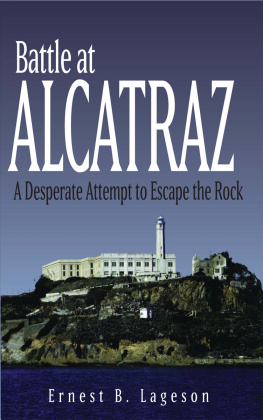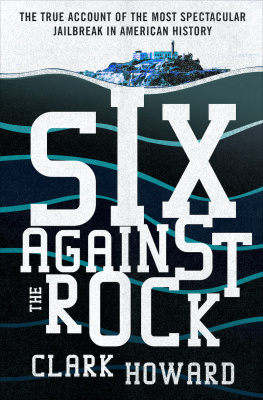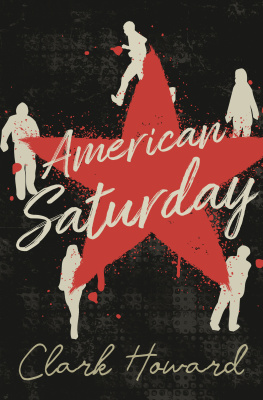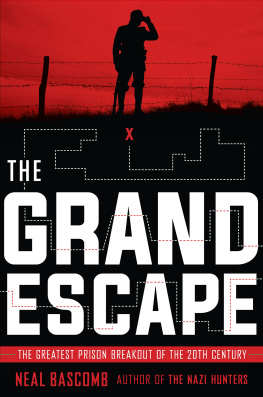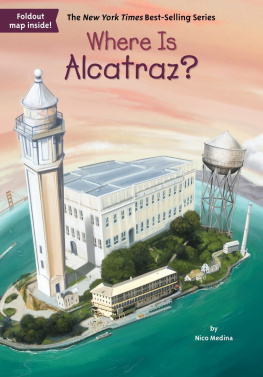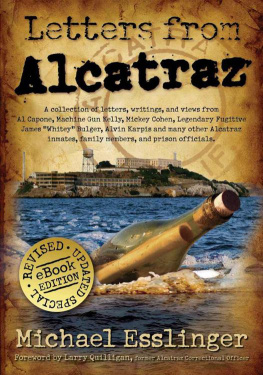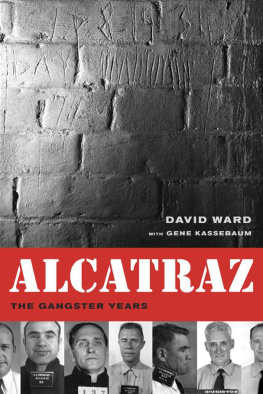An Addicus Nonfiction Book
Copyright 1999 by Ernest B. Lageson. All rights reserved. No part of this publication may be reproduced, stored in a retrieval system, or transmitted in any form or by any means, electronic, mechanical, photocopied, recorded, or otherwise, without the prior written permission of the publisher. For information, write Addicus Books, Inc., P.O. Box 45327, Omaha, Nebraska 68145.
ISBN#: 1-886039-37-2
ISBN#: 978-1-886039-37-7
Cover design by Jeff Reiner, Tim Young, Darcy Lijoodi
Typography by Linda Dageforde
Illustrations by Bob Hogenmiller
Library of Congress Cataloging-in-Publication Data
Lageson, Ernest B., 1932
Battle at Alcatraz : a desperate attempt to escape the rock / Ernest B. Lageson.
cm.
Includes bibliographical references (p.).
ISBN 1-886039-37-2 (alk. paper)
1. United States Penitentiary, Alcatraz Island, California. Prison riots. California. Case studies. I. Title.
HV9474.A4L34 1999
365.641.dc21
98-41824
CIP
Addicus Books, Inc.
P.O. Box 45327
Omaha, Nebraska 68145
www.AddicusBooks.com
Printed in the United States of America
To the memory of my father, who has been a source
of inspiration and a role model for me all my life.
Authors Notes
B attle at Alcatraz should have been written by my father, Ernie Lageson Sr. He is the one who lived the incredible experience. However, his untimely death intervened, so I have written this account in tribute to him.
My father worked as a custodial officer at Alcatraz between 1942 and 1948, with a brief hiatus while he served in the Navy during World War II. He was the officer in charge of the cell house on that fateful day in 1946 when the bloody insurrection occurred. He was taken hostage, shot, and left for dead for several hours before he was rescued. Later, he was also one of the key witnesses at the murder trial of the surviving rioters. A great deal of the information I used in writing this book came directly from my father.
Additionally, I did extensive research over the five years that I worked on this book. I scoured hundreds of newspaper articles covering the riot and the trial. I reviewed extensive portions of the FBI investigation file, including over a hundred statements from officers and prisoners. I also studied more than 2,500 pages of trial transcripts, hundreds of pages of court files, trial briefs, court opinions, and related documents. Most of the scenes and dialogue in the book are based on these documents.
I also interviewed former officers and former inmate Jim Quillan, who served time at Alcatraz in 1946. I had a brief meeting with Clarence Carnes, the only surviving inmate participant in the riot. My research also included in-depth interviews with Archer Zamloch, who represented Carnes at the trial.
Finally, some of the material for this book is based on my own memories. I lived in civilian quarters on Alcatraz Island when I was a boy of thirteen. Through my father, I met most of the custodial personnel depicted in this book. I was also the newspaper boy on Alcatraz Island, so I knew most of the residents from having delivered Bay Area newspapers to them.
Acknowledgments
A considerable number of people assisted me in preparing this book. I am sincerely grateful to them all.
First and foremost, I wish to recognize the contribution of my father, who not only lived the dramatic riot in May 1946 but also generously shared his recollections with me.
I am also grateful for the help of other members of my family. My daughter Kristine Cardall provided invaluable aid as my editor. Without her work, I probably would still be struggling with a rewrite. My son Ernie assisted with graphics and the artistic aspects of the work. Finally, my wife Jeanne contributed her thoughts, time, and encouragement to help make the whole thing happen.
I am appreciative of the research support I received from the staff at the National Archives in San Bruno, California, particularly from Neil Thomsen, Lisa Miller, and Claude Hopkins. I also wish to thank Michael Griffith, archivist for the U.S. District Court; Irene Stachura, librarian; and Bill Kooiman of the National Maritime Museum. Thanks, too, to the staffs of the San Francisco, Berkeley, Oakland, University of California, and Boalt Hall School of Law libraries for facilitating my research. I also thank Jennie Peuron for sharing with me her research on Sam Shockley, part of her work in writing the play Crazy Sam. Chuck Stucker, the son of Ed Stucker and himself a former resident of the island, provided a great deal of help with photographs as well as general support and encouragement.
The park rangers of the Golden Gate National Recreation Area, particularly John Cantwell, were extraordinarily cooperative and allowed me unlimited access to various Alcatraz venues. They are a dedicated group of professionals who do a wonderful job.
Special thanks go to a number of individuals who gave freely of their time and recollection. The following persons greatly assisted my research: the late Jim Quillan, an author and former inmate who was confined in D Block at the time of the riot; Mrs. Kay Sullivan, the widow of attorney William Sullivan, who defended Sam Shockley in his murder trial; Mrs. Annette Newmark, the widow of Aaron Vinkler, one of the attorneys for Miran Thompson; Lois Vinkler and Hermine Simon, the daughters of Aaron Vinkler; Archer Zamloch, the attorney who defended Clarence Carnes; George Finnigan, former law partner of Aaron Vinkler and longtime San Francisco practitioner; the late Judge Joseph Karesh, former assistant U.S. attorney and counsel for the Alcatraz administration; Jeannie Comerford Campbell; and Donald Martin, a close friend of my father and former Alcatraz custodial officer.
Finally, I wish to thank my longtime friend and widely acclaimed writer, Ron Fimrite, for his time and editorial comment.
Prologue
A lcatraz inmate Bernard Bernie Coy lay on his bunk, smoking and staring into the semidarkness of his five-by-nine-foot cell 155. As the harsh smoke from the hand-rolled Bull Durham cigarette filled his lungs, he contemplated what was about to become the single biggest event in his long and violent criminal career. Today he would lead a blastout from Alcatraz that would overshadow everything he had done in his life and make him one of the most famous inmates in the history of the island prison. Tomorrow his name and picture would be on the front page of every major newspaper in America and, given the public interest in Alcatraz, his fame might even reach international proportions.
Coy had dreamed about escaping for years. His active planning had gone on for months. He believed everything was now in place. He knew every move of all the cell-house officers and where they normally were at all times of the day. He knew the numbers and locations of all the critical keys. The tools he would need were in place and ready. The timing had been planned in great detail. The people were set. It had to work. There was no way it would fail.
Coy thought again about his hand-picked gang and how carefully he had selected them. Each was tough and courageous. Buddy Thompson and Marv Hubbard were solid. Both had shot it out with the police in the past. Coy was sure he could count on them. Hubbard, in particular, had demonstrated tremendous courage in police gunfights against tremendous odds and in many cases had escaped. Thompson, the Texas cop killer, was cool and self-assured, not easily excited or rattled. Coy wondered about the Indian kid, though. Joe Carnes was only eighteen years old, doing life for murder and kidnapping. How would he react if things really got tough? Coy had studied the young convict closely for months but had only recently told him of the breakout plans. Carnes was eager to be a part of it. Coy was satisfied that he could at least count on the youngster to do what he was told.
Next page
